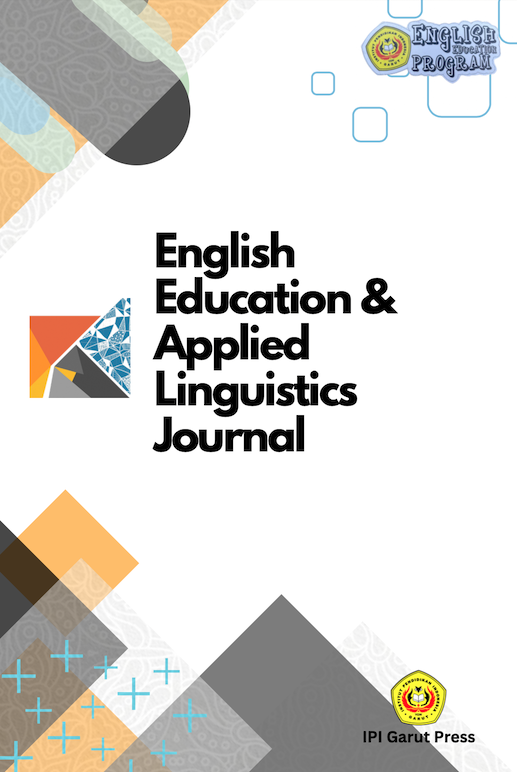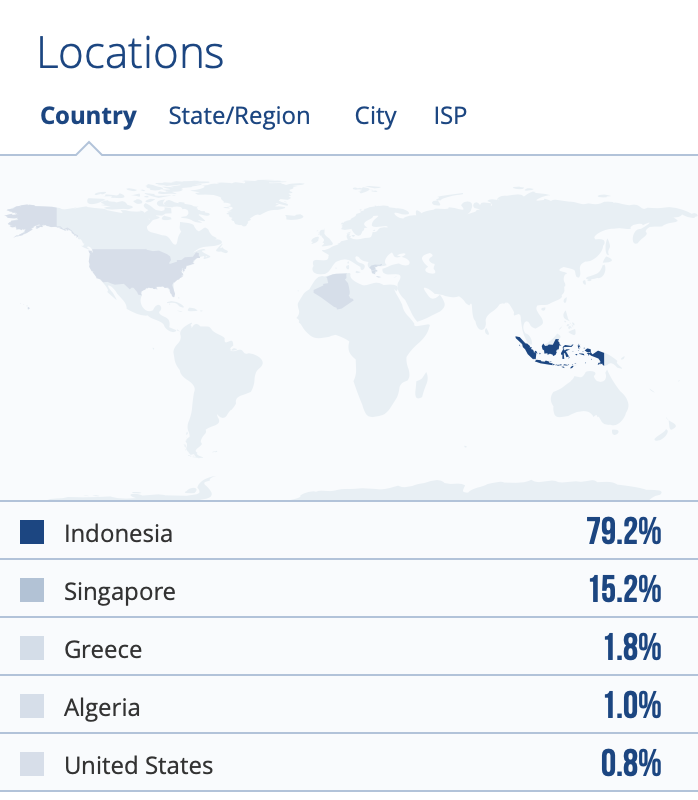Teachers’ Questions on Students’ Participations A Discourse Analysis in Fourth-Year English Education Program
DOI:
https://doi.org/10.31980/eealjournal.v8i2.2621Keywords:
impact, interaction, participation, teacher questioningAbstract
Participation in the classroom plays an important role because learning occurs through the interaction between the teacher and the students. However, many students do not participate in class, which can hinder effective communication and limit opportunities for collaborative learning. Then, one effective strategy to encourage participation is to pose questions to the students. This study aims to identify the types of questions most frequently used by the teacher and investigate the impact of these question types on fostering student participation in class. The data were collected through classroom observations and interviews consisting of a group of fourth-year students and one copywriting lecturer at an institution in the city of Garut. Observations were conducted just to determine what types of questions were frequently used by lecturers, followed by interviews to determine the impact of each type of question. The results of the observation showed that the most frequently used type of question was the closed type. Then from the interviews the researcher found that closed and convergent questions encouraged more participation because the questions could be answered briefly and more definitely. Recall questions and open questions reduced interest in participation because the questions require complex answers.
Keywords: impact, interaction, participation, teacher questioning
References
Abdullah, Mohd. Y., Bakar, N. R. A., & Mahbob, M. H. (2012). The Dynamics of Student Participation in Classroom: Observation on Level and forms of Participation. Procedia-Social and Behavioral Sciences, 59, 61–70. https://doi.org/10.1016/j.sbspro.2012.09.246
Al-Zahrani, M. Y., & Al-Bargi, A. (2017a). The Impact of Teacher Questioning on Creating Interaction in EFL: A Discourse Analysis. English Language Teaching, 10(6), 135. https://doi.org/10.5539/elt.v10n6p135
Bandura, A. (1977). Self-efficacy: Toward a unifying theory of behavioral change. Psychological Review, 84(2), 191–215. https://doi.org/10.1037/0033-295X.84.2.191
Berger, C. R., & Calabrese, R. J. (1975). Some explorations in initial interaction and beyond: Toward a developmental theory of interpersonal communication. Human Communication Research, 1(2), 99–112. https://doi.org/10.1111/j.1468-2958.1975.tb00268.x
Boyd, M., & Rubin, D. (2006). How contingent questioning promotes extended student talk: A function of display questions. Journal of Literacy Research, 38(2), 141–169.
Chaudron, C. (1988). Second Language Classrooms: Research on Teaching and Learning. Cambridge University Press.
Connor Desai, S., & Reimers, S. (2019). Comparing the use of open and closed questions for Web-based measures of the continued-influence effect. Behavior Research Methods, 51(3), 1426–1440. https://doi.org/10.3758/s13428-018-1066-z
Creswell, J. W. (2012). Educational Research_ Planning, Conducting, and Evaluating Quantitative and Qualitative Research, 4th Edition (A. Wesley, Ed.; 4th ed.). Pearson Education, Inc.
Cullen, R. (2002). Supportive teacher talk: The importance of the F-move. ELT Journal, 56(2), 117–127.
Eccles, J. S., & Wigfield, A. (2020). Expectancy-Value Theory. In H. T. G. V. W. L. M. V. J. S. H. G. (Eds.), The International Encyclopedia of Education (pp. 1–10). Elsevier. https://doi.org/10.1016/B978-0-12-818630-5.14020-5
Fajria, R., Aziz, Z., & Aulia, M. (2024). Questioning in the EFL Classroom: Teachers’ and Students. Perspectives. Al-Ta Lim Journal, 31(3), 31. https://doi.org/10.15548/jt.v31i3.922
Farahian, M., & Rezaee, M. (2012). A Case Study of an EFL Teacher’s Type of Questions: An Investigation into Classroom Interaction. Procedia - Social and Behavioral Sciences, 47, 161–167. https://doi.org/10.1016/j.sbspro.2012.06.631
Fontana, F., & Frey, J. (2000). The interview: From structured questions to negotiated text. In N. K. Denzin & Y. S. Lincoln (Eds.), Handbook of qualitative research (pp. 645–672). Thousand Oaks, CA: Sage.
Hasanuddin, N., & Ciptaningrum, D. S. (2021). Types of English Teachers’ Questioning and Classroom Interaction Affecting Learners’ Motivation in EFL Context. Indonesian Journal of EFL and Linguistics, 6(2), 455. https://doi.org/10.21462/ijefl.v6i2.405
Kasmiati, K. (2021). Classroom Discourse Analysis on Language Interaction at the 1st Level Class of STAR English Course Parepare (Doctoral dissertation, IAIN Parepare).
Mercer, S., & Dörnyei, Z. (2020). Motivation and the self-system in language learning. Routledge.
Schunk, D. H., & DiBenedetto, M. K. (2021). Self-efficacy and academic performance: A systematic review of the literature. Journal of Educational Psychology, 113(2), 295–320.
Sweller, J. (1988). Cognitive load during problem solving: Effects on learning. Cognitive Science, 12(2), 257–285. https://doi.org/10.1207/s15516709cog1202_4
Sweller, J. (2021). Why inquiry-based approaches harm students' learning. The Centre for Independent Studies, Australia.
Zajonc, R. B. (1965). Social facilitation. Science, 149(3681), 269–274. https://doi.org/10.1126/science.149.3681.269
Kucuktepe, C. (2010). Examination of question types used by elementary school teachers in the process of teaching and learning. Procedia - Social and Behavioral Sciences, 2(2), 5190–5195. https://doi.org/10.1016/j.sbspro.2010.03.844
Long, M. H., & Sato, C. J. (1983). Classroom foreigner talk discourse: Forms and functions of teachers’ questions. In H. W. Seliger & M. H. Long (Eds.), Classroom Oriented Research in Second Language Acquisition (pp. 268–285). Newbury House
Nazarieh, M., & Beigzadeh, A. (2019). Identification of the reasons behind students’ lack of participation in classroom activities using a Delphi technique. https://doi.org/10.22038/FMEJ.2019.15154.1091
Prasetianto, M. (2019). Kinds Of Questions Making Efl Students Learn: Students’ Perception. Joall (Journal of Applied Linguistics & Literature), 4(2), 162–176. https://doi.org/10.33369/joall.v4i2.7607
Rachmawaty, N., & Ariani, S. (2019). Investigating The Types Of Teacher Questions In Efl Secondary Classroom.
Richards, J. C., & Lockhart, C. (1996). Reflective Teaching in Second Language Classrooms. Cambridge University Press.
Sert, O. (2015). Social Interaction and L2 Classroom Discourse. Edinburgh University Press Sinclair, J. M., & Coulthard, R. M. (1975). Towards an Analysis of Discourse: The English Used by Teachers and Pupils. Oxford University Press.
Sugiyono. (2013). Metode Penelitian Kuantitatif Kualitatif Dan R&D. Alfabeta, Cv.
Yahya, R. A., & Kaniadewi, N. (2024). EFL students’ perception on the type of teacher quetions: A qualitative descriptive study. Jurnal Pendidikan Glasser, 8(2), 177–188. https://doi.org/10.32529/glasser.v8i2.3272
Wajnryb, R. (1992). Classroom observation tasks: A resource book for language teachers and trainers. Cambridge University Press.
Walsh, S. (2011). Exploring classroom discourse: Language in action. Routledge.
Downloads
Published
How to Cite
Issue
Section
License
Copyright (c) 2025 English Education and Applied Linguistics Journal (EEAL Journal)

This work is licensed under a Creative Commons Attribution-NonCommercial-ShareAlike 4.0 International License.






